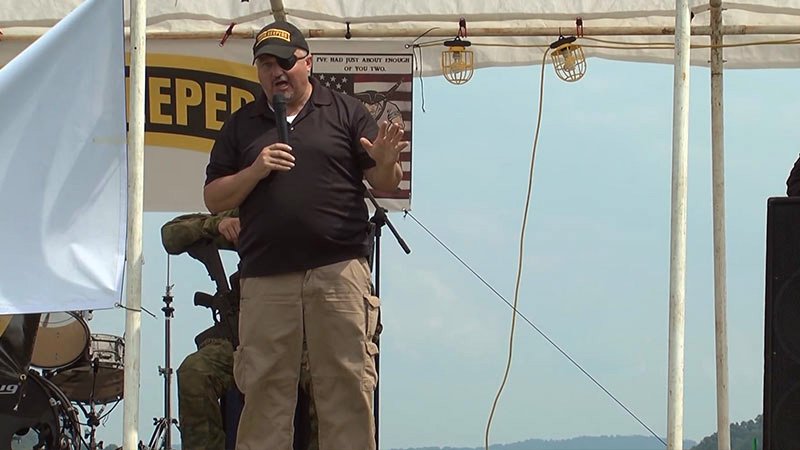Seditious Conspiracy Hits Oath Keepers Leader
Can the Feds Pull it Off?
The indictment of Elmer Stewart Rhodes III and ten other members of the far-right paramilitary group, the Oath Keepers, for seditious conspiracy looks strong. The charging document details a step-by-step plan by the group for ensuring that election laws were not followed. They had weapons stashed and the apparent will to use them. They also grew disgruntled with Trump. Early in the afternoon of January 6, Rhodes messaged his leadership group, “Pence is doing nothing…All I see Trump doing is complaining. I see no intent by him to do anything. So the patriots are taking it into their own hands.”
The defendants are of all ages, and most are from the south. Thomas Caldwell is 67 and lives in Berryville, Virginia. Joseph Hackett is 51 and comes from Sarasota, Florida. Also from Florida is Kenneth Harrelson, 41, of Titusville, Kelly Meggs, 52, of Dunnellon, and David Moerschel, 44, of Punta Gorda, a village not far from the Everglades National Park. Jessica Watkins, 39, is from Woodstock, Ohio. Brian Ulrich, 44, is from Guyton, Georgia. Robert Minuta, 37, lives in Prosper, Texas. Joshua James, 34, comes from Arab, Alabama. Finally, from Phoenix, Arizona, comes Edward Vallejo, 63. He is charged with running a special armed team camped at a hotel near the Capitol.
Rhodes is a former Army paratrooper and a Yale Law School graduate. He wears an eye patch because of a 1993 accidental shooting, and his ex-wife believes he is a “sociopath.” He lives in Granbury, Texas.
The indictment also tells us what the Oath Keepers were doing in D.C. on January 6 and how they were doing it. There doesn’t seem to be an encrypted message or communications code that federal agents have not cracked. The key to these seditious conspiracy charges appears to be that though they didn’t have weapons with them, weapons were clearly within the purview of the Oath Keepers who were already in the Capitol Building.
Remember, it is not the actual act of sedition for which they will be tried; it is seditious conspiracy. This means they talked about doing it, had the means to do it, and were inches away from committing it. As such, the activities for which they are charged come close to those protected by the First Amendment.
In this instance, however, the charge is conspiring to oppose by force the execution of the laws governing the transfer of presidential power. It should be a rung much more easily breached by the prosecution.
This case is a turning point in the larger discussion of January 6, 2021. Rhodes’s statement that it was “patriots,” not “Antifa” active that day, should (but probably will not) put an end to one of the conservative movement’s lies about that day. His conviction, and that of his co-indicted, might move some of those who hold dangerous delusions towards greater truthfulness. But a loss would mean that more of the worst of us will hold sway. It could get more dangerous now.
As Captain Hook used to say: “That is where the canker gnaws.”
Since World War II, there have been three times that the far-rightists, white supremacists, or neo-Nazis have been charged with seditious conspiracy. The first was a huge trial that began with 30 defendants during World War II. The judge died eight months into the trial, and neither President Roosevelt nor President Truman after him wanted it to continue. The Hitlerites walked away from it all.
The second trial was in 1988 in Ft. Smith, Arkansas. It had defendants from The Order RICO trial in Seattle in 1985, plus the nominal head of Aryan Nations, Richard Butler, and the spokesmen for a clandestine underground, Robert Miles and Louis Beam. Beam, who gave his own opening remarks, served as a catalyst for the defense. I attended the opening days of that trial, refrained from bad behavior on the elevator ride with Richard Butler, and kept close track of all the proceedings. They were all captured in three chapters of my book, Blood and Politics: The History of the White Nationalist Movement From the Margins to the Mainstream (FSG 2009). And I was not the least bit surprised when an all-white jury found them all innocent. The movement did not turn toward violence in 1989, however. Instead, it was captured in the moment by David Duke’s successful three-year ride in Republican Party campaigns.
The third attempt was in Michigan in 2010, when nine members of the Hutaree Militia group were charged with seditious conspiracy. The leader and his son were convicted of owning machine guns, but the judge threw out the larger charges in 2012 when the case came before the court. The militia leader’s wife, who was also indicted but not convicted, told reporters, “We weren’t dangerous. We couldn’t overthrow F-Troop.” If a conviction had been secured, the growth of the militia movement after 2012 might have been aborted. However, it was not to be.
As I wrote in Blood and Politics, “American courts had a history of convicting dozens of Puerto Ricans and communists for seditious conspiracy, but not one white supremacist or Nazi.”




